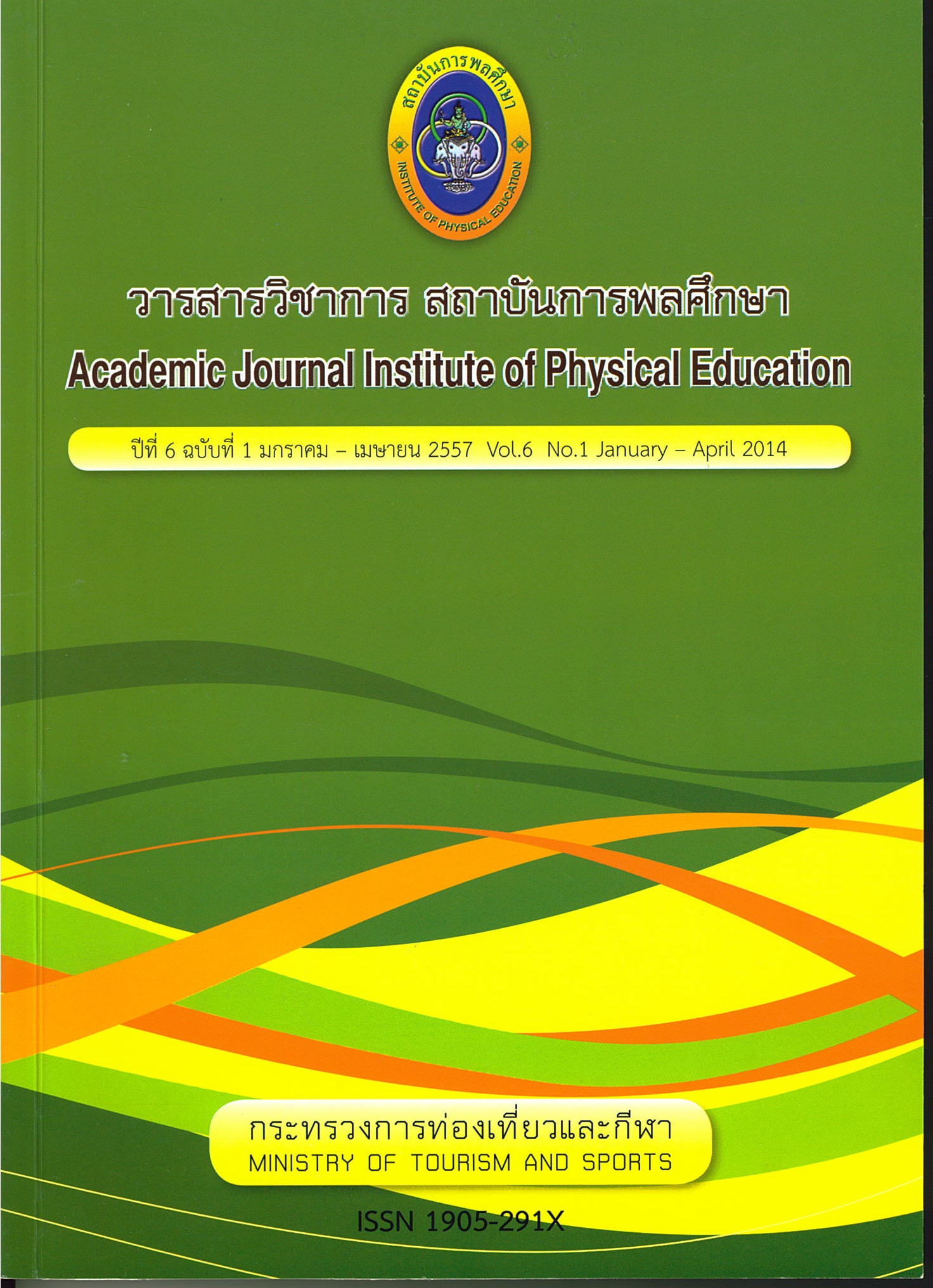Tourism Promotion for the Senior Japanese Tourists Market in Thailand
Main Article Content
Abstract
The purpose of this research was to study the tourism promotion for the senior Japanese tourists market in Thailand. The sample size included 1) a group of 400 senior Japanese tourists aged 55 years and above by purposive sampling. The collected information was analyzed by frequency distribution, percentage, average, and standard deviation. Moreover, the Marketing Mix of the senior Japanese tourists that came to Thailand were compared; namely, Product, Price, Place or Distribution, Promotion, People, Physical Evidence, and Process. All the information was examined by t-test according to their gender, age, and length of stay. 2) Twelve Thai tourism stakeholders that expertise in the Japanese market were interviewed by semi-structured interview. The results showed that the majority of the sample size were female, retired, revenue of about 2,500,000-5,000,000 Yen/year or 750,000-1,500,000 Baht/year, a source of income from private business, have a bachelors degree, most of them were FITs, travel to Thailand 2-5 times, stay in Thailand 11-20 days, know information about Thailand from friends and relatives, travel to Thailand because of safety, most of them spend their money on tourism attractions, enjoy Thailand to a great extent, and will come back to Thailand again and/or recommend Thailand to their friends and relatives. The overall evaluation of the marketing mix received a high level. Process, Physical Evidence, and Price got the highest level, respectively. Apart from that were People, Promotion, Product, and Place or Distribution which got a high level. There was no differences in opinion among different gender and age, statistically significant at the 0.05 level. Anyhow, there were differences in opinion regarding the length of stay, statistically significant at the 0.05 level. The study pointed out that the promotion of senior Japanese tourists to Thailand should work in partnership with all sectors. The appropriate forms of tourism for the senior Japanese tourists market are voluntourism, cultural tourism, golf tourism, and health tourism
Article Details

This work is licensed under a Creative Commons Attribution-NonCommercial-NoDerivatives 4.0 International License.
The published article is a copyright of the Academic Journal of Thailand National Sports University. The passage appeared in each article in this academic journal is a perspective of each author which is not related to the journal. Each author is required to be responsible for all components of his/her own article. If there are any mistakes, each author must be responsible for those mistakes on his/her own.
References
นิศา ชัชกุล. (2550), อุตสาหกรรมการท่องเที่ยว กรุงเทพมหานคร: สํานักพิมพ์แห่งจุฬาลงกรณ์มหาวิทยาลัย.
บุญเลิศ จิตตั้งวัฒนา. (2548) อุตสาหกรรมท่องเที่ยว กรุงเทพมหานคร: เพรส แอนด์ ดีไซน์ จํากัด.
ปัญตา เกตุเรืองโรจน์. (2553), จับตาการท่องเที่ยวไทยหลังวิกฤติเศราฐกิจโลก. [ออนไลน์]. แหล่งที่มา :
http://www.bangkokbiznews.com/home/detail/politics/openion/jangsibia/20100322/106309/จับตาการท่องเที่ยวไทยหลังวิกฤติเศรษฐกิจโลก.htm [2555, สิงหาคม 16]
มนสิชา อินทจักร. (2550), การท่องเที่ยวเชิงวัฒนธรรมในประเทศไทยสําหรับนักท่องเที่ยวสูงอายุชาวญี่ปุ่น. วารสารวิชาการอิเล็กทรอนิกส์การท่องเที่ยวไทยนานาชาติ, 2552(1), 1-10.
ราณี อิสิชัยกุล. (2553). การส่งเสริมการท่องเที่ยวผู้สูงอายุจากทวีปยุโรปสู่ประเทศไทย. วารสารการ บริการและการท่องเที่ยวไทย, 5(1), 49 - 66.
ลัดดาวัลย์ เพชรโรจน์ และ อัจฉรา ชํานิประศาสน์. (2547). ระเบียบวิธีการวิจัย กรุงเทพมหานคร: พิมพ์ดีการพิมพ์ จํากัด.
สถาบันวิจัยและให้คําปรึกษามหาวิทยาลัยธรรมศาสตร์. (2545). แนวทางการส่งเสริมและพัฒนาการท่องเที่ยวพํานักระยะยาว : กรณีศึกษาเฉพาะนักท่องเที่ยวอายุ 50 ปีขึ้นไปที่เดินทางมาเพื่อการพักผ่อน (รายงานผลการวิจัย), กรุงเทพฯ : ผู้แต่ง.
สมยศ วัฒนากมลชัย และเยาวลักษณ์ ยิ้มอ่อน. (2554). นักท่องเที่ยวสูงอายุ : กลุ่มเป้าหมายที่มีศักยภาพสําหรับธุรกิจการท่องเที่ยว, วารสารปัญญาภิวัฒน์, 2(1), 95-103.
สมบัติ กาญจนกิจ. (2544), นันทนาการและอุตสาหกรรมการท่องเที่ยว กรุงเทพมหานคร: ทํามาดี จํากัด.
สุดธิดา เปลี่ยนคารมย์. (2555). “โอกาส” ใน “วิกฤติ” จากสังคมผู้สูงอายุ. [ออนไลน์]. แหล่งที่มา :
http://www.oknation.net/blog/print.php?id=104233 [2555, สิงหาคม 16].
อาภรณ์ ชีวะเกรียงไกร. (2555). เกษียณอย่างมีคุณค่า แบบอย่างคนญี่ปุ่น. [ออนไลน์]. แหล่งที่มา :
http://www.moneymartthai.com/daily/index.php?cat dd5c07036f2975ffabce568b6511d3bc&know id=223 [2555, สิงหาคม 16]
แผนการตลาดการท่องเที่ยวปี 2555. (2554). กรุงเทพฯ : การท่องเที่ยวแห่งประเทศไทย.
สถานการณ์ตลาดนักท่องเที่ยวต่างประเทศเดินทางเข้าประเทศไทย ปี 2554 และแนวโน้มปี 2555 (2555). กรุงเทพฯ : การท่องเที่ยวแห่งประเทศไทย
สถานการณ์นักท่องเที่ยวญี่ปุ่นปี 2554. (2555). กรุงเทพฯ : การท่องเที่ยวแห่งประเทศไทย.
อรลักษณ์ ชิดเชี่ยว. (2550). การพัฒนาประเทศไทยให้เป็นแหล่งท่องเที่ยวผู้้สูงอายุ. วิทยานิพนธ์ปริญญามหาบัณฑิต, มหาวิทยาลัยสงขลานครินทร์, สงขลา.
Amadeus. (2011). Publication Future Traveller Tribes 2020. Madrid : Author.
Hongsranagon, P. (2005). Advisory Facilities for Long-stay Japanese Senior Travellers in Chiangmai. MANUSYA :The Journal of Humanities, 8(2), 58-66.
Hongsranagon, P. (2006). Japanese Senior Tourists-An Untapped Potential in Thailand's Tourism Industry. The Journal of Behavioral Science, 1(1), 55-61.
International Tourist Arrivals to Thailand 1987-2011. (2012). Bangkok : Department of Tourism.
Report of Longstay in Japan. (2011). Bangkok : Tourism Authority of Thailand.
The World Factbook : Japan. CIA [online]. Available from : https://www.cia.gov/library/publications/the-world-factbook/geos/ja.html [2012, July 5]
JTB Report 2011. (2011). Tokyo : Japan Tourism Marketing Co.
Kotler, P. (2001). Principles of Marketing. 9th Edition. N.J.: Prentice Hall.
Watkins, L. (2008). Japanese Travel Culture : An Investigation of the Links Between Early Japanese Pilgrimage and Modern Japanese Travel Behaviour. New Zealand Journal of Asian Studies, 10(2), 93-110.
Yamane, T. (1967). Statistic and Introduction Analysis. 2nd ed. New York : Harper and Row.

